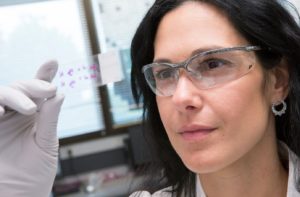Genethon assesses a therapeutic potential of a Dual AAV vector approach for Duchenne muscular dystrophy
In a study published in the International Journal of Molecular Sciences on July 13th, Genethon’s researcher Sonia Albini, deployed a dual AAV approach to deliver quasidystrophin.
Duchenne Muscular dystrophy (DMD) is caused by the lack of dystrophin, a muscle protein essential for the integrity of muscle fibers. Gene therapy for DMD, employing the adeno-associated virus (AAV) face the challenge imposed by the limited packaging capacity of AAV. The dystrophin gene, whose coding sequence is important (11kb) can’t be fully integrated into this vector (1 AAV = 4.5kb).
In the therapeutic strategies currently implemented, researchers use a short version of dystrophin (µDys), that presents limitations due to its reduced size.
Faced with this observation, Sonia Albini, researcher in the Progressive Muscular Dystrophies team, led by Isabelle Richard, develops a dual AAV vector approach for the expression of a larger dystrophin version (qDys): quasidystrophin.

This approach is based on homologous recombination, and the development of a methodology employing a strategic droplet digital PCR design, to determine the efficiency and accuracy of transgene reconstruction.
In this publication, researchers demonstrated that the dual AAV vector for quasidystrophin (qDys) injected into DMD model mice, led to high transgene reconstitution efficiency with consequent remarkable protein restoration in muscles and improvement of muscle pathology.
« This study marks an important step forward in the treatment of Duchenne muscular dystrophy for Généthon. Quasidystrophin has the potential to alleviate the disease, using two viral vectors whose safety has been demonstrated thanks to our approach,” concludes Sonia Albini.
To find out more :
Sonia Albini, Laura Palmieri, Auriane Dubois, Nathalie Bourg, William Lostal and Isabelle Richard
Assessment of Therapeutic Potential of a Dual AAV Approach for Duchenne Muscular Dystrophy

